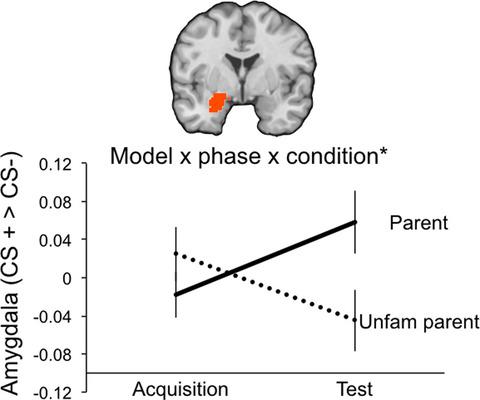Our official English website, www.x-mol.net, welcomes your
feedback! (Note: you will need to create a separate account there.)
An exploration of amygdala‐prefrontal mechanisms in the intergenerational transmission of learned fear
Developmental Science ( IF 3.1 ) Pub Date : 2020-10-26 , DOI: 10.1111/desc.13056 Jennifer A Silvers 1 , Bridget L Callaghan 1 , Michelle VanTieghem 2 , Tricia Choy 3 , Kaitlin O'Sullivan 2 , Nim Tottenham 2
Developmental Science ( IF 3.1 ) Pub Date : 2020-10-26 , DOI: 10.1111/desc.13056 Jennifer A Silvers 1 , Bridget L Callaghan 1 , Michelle VanTieghem 2 , Tricia Choy 3 , Kaitlin O'Sullivan 2 , Nim Tottenham 2
Affiliation

|
Humans learn about their environments by observing others, including what to fear and what to trust. Observational fear learning may be especially important early in life when children turn to their parents to gather information about their world. Yet, the vast majority of empirical research on fear learning in youth has thus far focused on firsthand classical conditioning, which may fail to capture one of the primary means by which fears are acquired during development. To address this gap in the literature, the present study examined observational fear learning in youth (n = 33; age range: 6–17 years) as they watched videos of their parent and an “unfamiliar parent” (i.e., another participant's parent) undergo fear conditioning. Youth demonstrated stronger fear learning when observing their parent compared to an unfamiliar parent, as indicated by changes in their self‐reported liking of the stimuli to which their parents were conditioned (CS+, a geometric shape paired with an aversive noise; CS‐, a geometric shape never paired with an aversive noise) and amygdala responses. Parent trait anxiety was associated with youth learning better (i.e., reporting a stronger preference for the CS‐ relative to CS+), and exhibiting stronger medial prefrontal‐amygdala connectivity. Neuroimaging data were additionally acquired from a subset of parents during firsthand conditioning, and parental amygdala and mPFC activation were associated with youth's neural recruitment. Together, these results suggest that youth preferentially learn fears via observation of their parents, and this learning is associated with emotional traits and neural recruitment in parents.
中文翻译:

习得性恐惧代际传递中杏仁核-前额叶机制的探索
人类通过观察他人来了解他们的环境,包括害怕什么和信任什么。当孩子们求助于父母来收集有关他们世界的信息时,观察性恐惧学习可能在生命早期尤为重要。然而,迄今为止,绝大多数关于青年恐惧学习的实证研究都集中在第一手经典条件反射上,这可能无法捕捉到在发展过程中获得恐惧的主要方式之一。为了解决文献中的这一差距,本研究调查了青少年(n = 33;年龄范围:6-17 岁)在观看父母和“不熟悉的父母”(即另一名参与者的父母)的视频时的观察性恐惧学习经历恐惧条件反射。与不熟悉的父母相比,青少年在观察父母时表现出更强的恐惧学习能力,正如他们自我报告的对父母所适应的刺激(CS+,几何形状与厌恶噪音配对;CS-,几何形状从未与厌恶噪音配对)和杏仁核反应的变化所表明的。父母特质焦虑与青少年更好地学习有关(即,报告对 CS- 相对于 CS+ 的偏好更强),并表现出更强的内侧前额叶 - 杏仁核连接。神经影像数据是在第一手条件下从父母的子集额外获得的,父母的杏仁核和 mPFC 激活与青年的神经募集有关。总之,这些结果表明,青少年优先通过观察父母来学习恐惧,这种学习与父母的情绪特征和神经募集有关。
更新日期:2020-10-26
中文翻译:

习得性恐惧代际传递中杏仁核-前额叶机制的探索
人类通过观察他人来了解他们的环境,包括害怕什么和信任什么。当孩子们求助于父母来收集有关他们世界的信息时,观察性恐惧学习可能在生命早期尤为重要。然而,迄今为止,绝大多数关于青年恐惧学习的实证研究都集中在第一手经典条件反射上,这可能无法捕捉到在发展过程中获得恐惧的主要方式之一。为了解决文献中的这一差距,本研究调查了青少年(n = 33;年龄范围:6-17 岁)在观看父母和“不熟悉的父母”(即另一名参与者的父母)的视频时的观察性恐惧学习经历恐惧条件反射。与不熟悉的父母相比,青少年在观察父母时表现出更强的恐惧学习能力,正如他们自我报告的对父母所适应的刺激(CS+,几何形状与厌恶噪音配对;CS-,几何形状从未与厌恶噪音配对)和杏仁核反应的变化所表明的。父母特质焦虑与青少年更好地学习有关(即,报告对 CS- 相对于 CS+ 的偏好更强),并表现出更强的内侧前额叶 - 杏仁核连接。神经影像数据是在第一手条件下从父母的子集额外获得的,父母的杏仁核和 mPFC 激活与青年的神经募集有关。总之,这些结果表明,青少年优先通过观察父母来学习恐惧,这种学习与父母的情绪特征和神经募集有关。











































 京公网安备 11010802027423号
京公网安备 11010802027423号